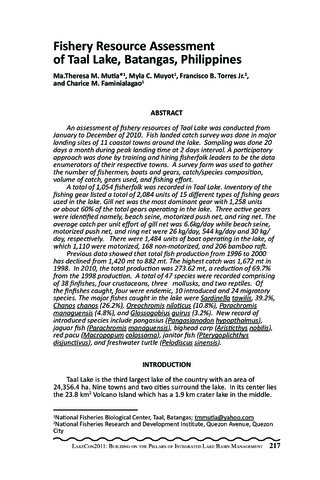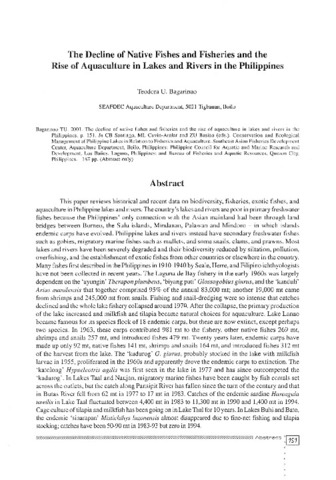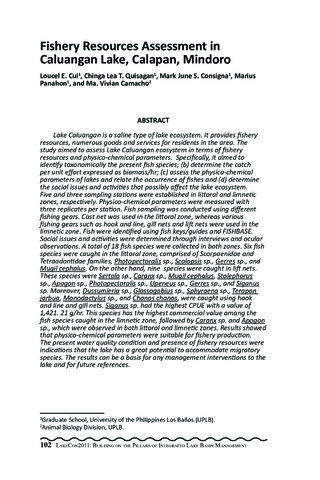Fishery resource assessment of Taal Lake, Batangas, Philippines
- Global styles
- MLA
- Vancouver
- Elsevier - Harvard
- APA
- Help

閲覧/開く
日付
2013Page views
9,514ASFA keyword
fishery resources 
evaluation
fishery surveys
fishers
fishing gear
fishing vessels
check lists
fishing effort
inventories
lakes
lake fisheries
livelihoods
fishery products
fishery biology
sampling
databases
data processing
abundance
catch-effort
endemic species
migratory species
dominant species
seasonality
fisheries

evaluation

fishery surveys

fishers

fishing gear

fishing vessels

check lists

fishing effort

inventories

lakes

lake fisheries

livelihoods

fishery products

fishery biology

sampling

databases

data processing

abundance

catch-effort

endemic species

migratory species

dominant species

seasonality

fisheries

AGROVOC keyword
Taxonomic term
Geographic names
Metadata
アイテムの詳細レコードを表示する
Share
抄録
An assessment of fishery resources of Taal Lake was conducted from January to December of 2010. Fish landed catch survey was done in major landing sites of 11 coastal towns around the lake. Sampling was done 20 days a month during peak landing time at 2 days interval. A participatory approach was done by training and hiring fisherfolk leaders to be the data enumerators of their respective towns. A survey form was used to gather the number of fishermen, boats and gears, catch/species composition, volume of catch, gears used, and fishing effort.
A total of 1,054 fisherfolk was recorded in Taal Lake. Inventory of the fishing gear listed a total of 2,084 units of 15 different types of fishing gears used in the lake. Gill net was the most dominant gear with 1,258 units or about 60% of the total gears operating in the lake. Three active gears were identified namely, beach seine, motorized push net, and ring net. The average catch per unit effort of gill net was 6.6kg/day while beach seine, motorized push net, and ring net were 26 kg/day, 544 kg/day and 30 kg/day, respectively. There were 1,484 units of boat operating in the lake, of which 1,110 were motorized, 168 non-motorized, and 206 bamboo raft.
Previous data showed that total fish production from 1996 to 2000 has declined from 1,420 mt to 882 mt. The highest catch was 1,672 mt in 1998. In 2010, the total production was 273.62 mt, a reduction of 69.7% from the 1998 production. A total of 47 species were recorded comprising of 38 finfishes, four crustaceans, three mollusks, and two reptiles. Of the finfishes caught, four were endemic, 10 introduced and 24 migratory species. The major fishes caught in the lake were Sardinella tawilis, 39.2%, Chanos chanos (26.2%), Oreochromis niloticus (10.8%), Parachromis managuensis (4.8%), and Glossogobius guirus (3.2%). New record of introduced species include pangasius (Pangasianodon hypopthalmus), jaguar fish (Parachromis managuensis), bighead carp (Aristicthys nobilis), red pacu (Macropopum colossoma), janitor fish (Pterygoplichthys disjunctivus), and freshwater turtle (Pelodiscus sinensis).
Suggested Citation
Mutia, M. T. M., Muyot, M. C., Torres Jr., F. B., & Faminialagao, C. M. (2013). Fishery resource assessment of Taal Lake, Batangas, Philippines. In M. L. C. Aralar, A. S. Borja, A. L. Palma, M. M. Mendoza, P. C. Ocampo, E. V. Manalili, & L. C. Darvin (Eds.), LakeCon2011: Building on the pillars of Integrated Lake Basin Management (Second National Congress on Philippine Lakes) (pp. 217-229). Los Baños, Laguna, Philippines: PCAARRD-DOST.
Type
Conference paperISSN
1656-8099シリーズ
Summary of Proceedings No. 1/2013;Collections
- LakeCon2011 [30]
Related items
Showing items related by title, author, creator and subject.
-
The decline of native fishes and fisheries and the rise of aquaculture in lakes and rivers in the Philippines
Bagarinao, Teodora (Aquaculture Department, Southeast Asian Fisheries Development Center; Philippine Council for Aquatic and Marine Research and Development (PCAMRD), Department of Science and Technology; Bureau of Fisheries and Aquatic Resources, 2001)
This paper reviews historical and recent data on biodiversity, fisheries, exotic fishes, and aquaculture in Philippine lakes and rivers. The country's lakes and rivers are poor in primary freshwater fishes because the ...
(Aquaculture Department, Southeast Asian Fisheries Development Center; Philippine Council for Aquatic and Marine Research and Development (PCAMRD), Department of Science and Technology; Bureau of Fisheries and Aquatic Resources, 2001)
This paper reviews historical and recent data on biodiversity, fisheries, exotic fishes, and aquaculture in Philippine lakes and rivers. The country's lakes and rivers are poor in primary freshwater fishes because the ... -
Series: Summary of Proceedings No. 1/2013;
Fishery resources assessment in Caluangan Lake, Calapan, Mindoro
Cui, Loucel E.; Quisagan, Chinga Lea T.; Consigna, Mark June S.; Panahon, Marius; Camacho, Ma. Vivian (PCAARRD-DOST, 2013)Lake Caluangan is a saline type of lake ecosystem. It provides fishery resources, numerous goods and services for residents in the area. The study aimed to assess Lake Caluangan ecosystem in terms of fishery resources and ... -
The ichthyofauna of Lake Manguao, Taytay, Palawan, Philippines with special reference to endemic species
Matillano, Joie D. (Southeast Asian Regional Center for Graduate Study and Research in Agriculture (SEARCA), 2005)Lake Manguao is the only freshwater lake in mainland Palawan. It is special because it has no surface outflow that connects it to the sea. The fish fauna of Lake Manguao was studied during three sampling events in June, ...





